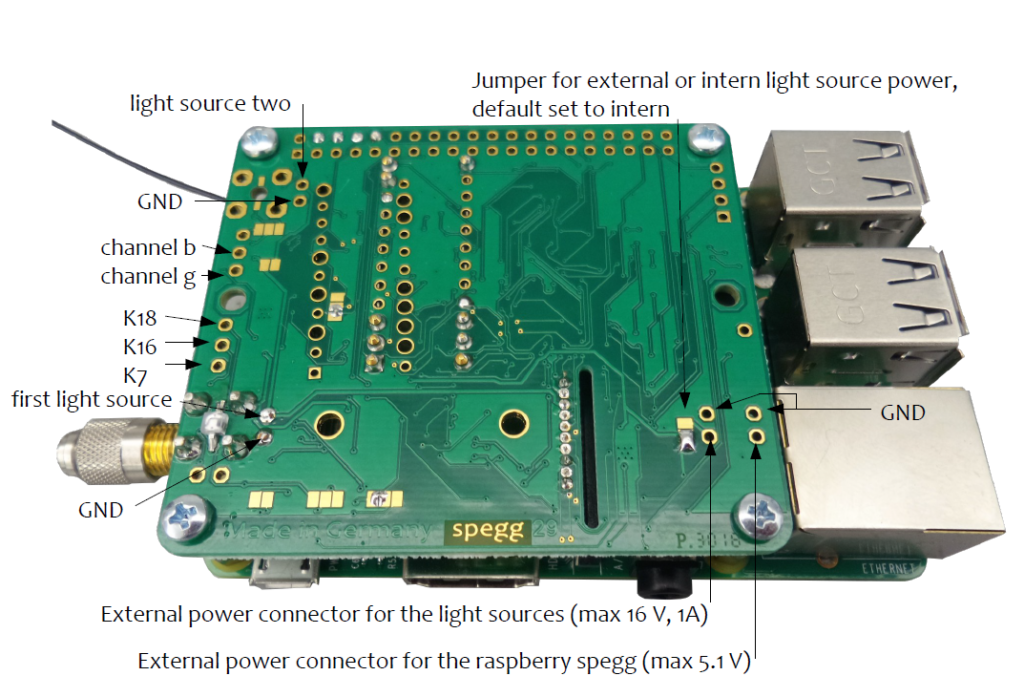![]() For industrial applications the reproducibility of spectral measurements and sturdiness and durability of the measuring device is crucial. For reproducibility of spectral measurements between different devices and within the lifetime of the spectrometer, the slit and the position of the grating, the mirror and the detector must be the same. Only this way spectral evaluations, e.g. for the determination of certain analyte concentrations, can be transferred to equivalent spectrometers.
For industrial applications the reproducibility of spectral measurements and sturdiness and durability of the measuring device is crucial. For reproducibility of spectral measurements between different devices and within the lifetime of the spectrometer, the slit and the position of the grating, the mirror and the detector must be the same. Only this way spectral evaluations, e.g. for the determination of certain analyte concentrations, can be transferred to equivalent spectrometers.
The raspberry spegg fulfills these requirements. Because of the monolithic setup the optical path is grounded over the entire lifetime. Each spectrometer is calibrated after production and does not need to be recalibrated. This manufacturing process ensures that the spectra of all raspberry spegg’s are comparable to each other. For each raspberry spegg, the calibration data is stored in the flash C of the microcontroller.
The electronic components of the raspberry spegg, including the integrated XenonLED375, also meet these requirements. E.g. no electrolytic capacitors with liquid electrolytes are used. The light source has its own electronically adjustable photodiode controlled voltage source or (default) adjustable control voltage. The LED power source can be set extern or (deflault) with the intern (5V) power source. Two analogue channels (channel b, g, max 4V) with 16bit resolution can read alternative to the spectrum.
The electronics and the spectrometer of the raspberry spegg are adjusted robustly and space-saving to the raspberry pi.
Only four GPIO’s (pin 4,6,8 and 10) are used for power supply and communication. All other GPIO’s (except 11-18) as well as the CSI Camera cable can be used with the raspberry spegg board. Three TTL output ports (K18, K16, K7) can be control by the spegg.
The raspberry spegg has a voltage supply connection with a polyfuse, which can also be used to supply the raspberry pi.
For more pictures click here. For more information here.
raspberry spegg © UVVIS29
Art.Nr.: LIVIS2900
EAN: 791732154719
delivery contents:
spegg © UVVIS29
16GBit SD card incl. demo Software in Python
Raspberry pi international power supply
specifications:
|
Spectral Range |
240 – 1050 nm |
|
Fiber |
Ø 300 / 330 µm; NA= 0,22 |
|
Fiber length from spegg board to top |
75cm +- 4cm |
|
Fiber connector |
male F-sma 905 |
|
Blazed Grating |
g = 4,7 µm / d = 0,2 µm |
|
Stray light Attenuation |
> 17dB with GG495 at 470 nm |
|
Spectral Resolution |
< 10 nm FWHM / 2 nmPixel |
|
Spectral Accuracy |
2 nm (typ. 1 nm) |
|
Inter Instrument Agr. |
typ. 0,5 nm |
|
Wavelength Stability |
0,05 nm/K |
|
Wavelength Repeatability (RT) |
0,05 nm |
|
Sensitivity (e.g. 500nm) |
> 20 E15 cts x nm/Ws |
|
Noise Equivalent Power |
3 pW 500nm; Ti 1s ; low signal 50 pW 500nm; high signal |
|
Dynamic Range |
> 5.000 ; low signal |
|
Electronics |
16 bit; UART; |
|
Wavelength range LED |
370 – 1050 nm |
|
Light source connector |
female F-sma 905 |
|
Storage Temperature |
– 40°C to +60°C |
|
Operating Temperature |
0°C to +40°C |
|
Max. rel. humidity (not condensing) |
85 % |
